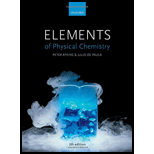
(a)
Interpretation:
The volume of oxygen is given up by
(a)
Answer to Problem 4.5PR
The volume of oxygen is given up by
Explanation of Solution
Heamoglobin concentration in normal blood is
Which also implies that
Heamoglobin in the lungs is about
According to the question,
In lung,
In capillary,
The amount of oxygen taken up by the body tissues will be
Therefore, the volume of oxygen is given up by
(b)
Interpretation:
The mass of nitrogen dissolved in
Concept Introduction:
Henry’s law:
The vapour pressure of a volatile solute A is proportional to its mole fraction in a solution.
Mathematically, it can be represented as
Where,
Another version of Henry’s law can be mathematically represented as
Where,
(b)
Answer to Problem 4.5PR
The mass of nitrogen dissolved in
Explanation of Solution
According to the given question, in
Air is
Substituting all the values in Henry’s law and solving for C,
Therefore, the mass of nitrogen dissolved in
Similarly, at
Therefore, the mass of nitrogen dissolved in
(c)
Interpretation:
The increase in nitrogen concentration in fatty tissue in going from
Concept Introduction:
Henry’s law:
The vapour pressure of a volatile solute A is proportional to its mole fraction in a solution.
Mathematically, it can be represented as
Where,
Another version of Henry’s law can be mathematically represented as
Where,
(c)
Answer to Problem 4.5PR
The increase in nitrogen concentration in fatty tissue in going from
Explanation of Solution
According to the question, nitrogen is 4 times as soluble in fatty tissues as in water.
So at
So at
The increase in nitrogen concentration in fatty tissue in going from
Want to see more full solutions like this?
Chapter 4 Solutions
Elements Of Physical Chemistry
- Calculate the pH and the pOH of each of the following solutions at 25 °C for which the substances ionize completely: (a) 0.000259 M HClO4arrow_forwardWhat is the pH of a 1.0 L buffer made with 0.300 mol of HF (Ka = 6.8 × 10⁻⁴) and 0.200 mol of NaF to which 0.160 mol of NaOH were added?arrow_forwardDetermine if the following salt is neutral, acidic or basic. If acidic or basic, write the appropriate equilibrium equation for the acid or base that exists when the salt is dissolved in aqueous solution. If neutral, simply write only NR. Be sure to include the proper phases for all species within the reaction. NaN₃arrow_forward
- A. Draw the structure of each of the following alcohols. Then draw and name the product you would expect to produce by the oxidation of each. a. 4-Methyl-2-heptanol b. 3,4-Dimethyl-1-pentanol c. 4-Ethyl-2-heptanol d. 5,7-Dichloro-3-heptanolarrow_forwardWhat is the pH of a 1.0 L buffer made with 0.300 mol of HF (Ka = 6.8 × 10⁻⁴) and 0.200 mol of NaF to which 0.160 mol of NaOH were added?arrow_forwardCan I please get help with this.arrow_forward
- Determine if the following salt is neutral, acidic or basic. If acidic or basic, write the appropriate equilibrium equation for the acid or base that exists when the salt is dissolved in aqueous solution. If neutral, simply write only NR. Be sure to include the proper phases for all species within the reaction. N₂H₅ClO₄arrow_forwardPlease help me with identifying these.arrow_forwardCan I please get help with this?arrow_forward
 ChemistryChemistryISBN:9781305957404Author:Steven S. Zumdahl, Susan A. Zumdahl, Donald J. DeCostePublisher:Cengage Learning
ChemistryChemistryISBN:9781305957404Author:Steven S. Zumdahl, Susan A. Zumdahl, Donald J. DeCostePublisher:Cengage Learning ChemistryChemistryISBN:9781259911156Author:Raymond Chang Dr., Jason Overby ProfessorPublisher:McGraw-Hill Education
ChemistryChemistryISBN:9781259911156Author:Raymond Chang Dr., Jason Overby ProfessorPublisher:McGraw-Hill Education Principles of Instrumental AnalysisChemistryISBN:9781305577213Author:Douglas A. Skoog, F. James Holler, Stanley R. CrouchPublisher:Cengage Learning
Principles of Instrumental AnalysisChemistryISBN:9781305577213Author:Douglas A. Skoog, F. James Holler, Stanley R. CrouchPublisher:Cengage Learning Organic ChemistryChemistryISBN:9780078021558Author:Janice Gorzynski Smith Dr.Publisher:McGraw-Hill Education
Organic ChemistryChemistryISBN:9780078021558Author:Janice Gorzynski Smith Dr.Publisher:McGraw-Hill Education Chemistry: Principles and ReactionsChemistryISBN:9781305079373Author:William L. Masterton, Cecile N. HurleyPublisher:Cengage Learning
Chemistry: Principles and ReactionsChemistryISBN:9781305079373Author:William L. Masterton, Cecile N. HurleyPublisher:Cengage Learning Elementary Principles of Chemical Processes, Bind...ChemistryISBN:9781118431221Author:Richard M. Felder, Ronald W. Rousseau, Lisa G. BullardPublisher:WILEY
Elementary Principles of Chemical Processes, Bind...ChemistryISBN:9781118431221Author:Richard M. Felder, Ronald W. Rousseau, Lisa G. BullardPublisher:WILEY





